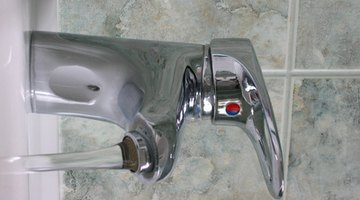Cheap Ways to Get Rid of Hard Water

Hard water, which contains high levels of mineral salts, is one of the most common problems homeowners face. Though not a health hazard, hard water can cause mineral deposits and limit the ability to form a lather when combined with soap. While getting rid of hard water is not necessarily difficult, it can be a rather expensive process. Fortunately, you don't have to spend a week's pay to do it, as there are a few inexpensive methods that will work perfectly.
Ion Exchange Water Softener
The most common way of dealing with hard water is to use an ion exchange water softener. This system uses two tanks (resin tank and salt tank) that work to soften the water by striping it of magnesium and calcium ions. While ion exchange water softening systems are effective, many people claim that the salt tank leeches trace amounts of sodium into the water, which can be a problem for people who have to watch their salt intake. Purchasing and installing an ion exchange water softening system cost between $400-$1,000. All in all, however, there is no more effective hard water treatment than an ion exchange water softener.
Polyphosphate Feeders
Polyphosphate feeders are an excellent alternative to ion exchange water softeners. As the water passes through a host of polyphosphate crystals, the minerals in the water (iron, magnesium, calcium) get coated in polyphosphate, which effectively reduces the hardness of the water. This is an effective and inexpensive ($150-$300) solution for homeowners with city water, but those with well water may want to look elsewhere, as polyphosphate can encourage the growth of bacteria.
Boiling
For those who have slightly hard water, simply boiling it may be the most cost-effective solution available. Boiling hard water can cause the minerals to deposit themselves at the bottom of the kettle, effectively creating soft water that is ready to use. Note that this method is not likely to work if the mineral content of your water is extremely high.
References
Writer Bio
Based in Portland, Maine, Kurt Larsen began his writing career in 2008. As well as being proficient in constructing marketing and website content, he has been published in media outlets such as Buildipedia, an interactive community focusing on green and sustainable architecture. Larsen holds a Bachelor of Arts in sociology from the University of Vermont.
Photo Credits
- tap image by BlueMiniu from Fotolia.com
- tap image by BlueMiniu from Fotolia.com
More Articles



